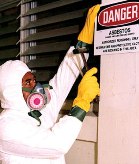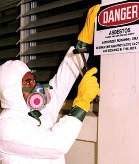
The Asbestos Debacle
- By Tony Nocito
- Sep 16, 2010
Society and industry are diligently working to find better solutions through waste reduction, recycling and reuse, but what is the plan for hazardous materials, such as asbestos, in buildings and property?
Known as the miracle mineral, asbestos was used for its resiliency against chemical attack and its excellent tensile strength and superior fire-proofing characteristics. The material was used in 3,000 to 5,000 products from the early 1800s through the 1970s.
Recognizing the effects of asbestos on human health, the U.S. Public Health Service recommended guidelines on asbestos exposure as early as 1938.
The start of World War II accelerated the expansion of existing military bases, building new bases and government facilities, and amplified shipbuilding, all of which used asbestos. The government also bought and stored raw asbestos in silos around the country, in case it became unavailable.
Obviously, Public Health Service recommendations were ignored then and many years into the future.
Ubiquitous, asbestos containing materials (ACM) were installed in American factories, electric utilities and generating plants, schools, homes, and process industry during the 20th century, causing about than 4,000 deaths a year in the United States, making asbestos exposure the deadliest industrial tragedy in American history.
The U.S. EPA says an estimated 27 million people were exposed to asbestos in the workplace between the years of 1940 though the 1970s. As long as asbestos is in the built environment, the exposure will continue.
Asbestos remains one of the costliest environmental challenges facing the United States. Because it was so widely used and permeates our environment, asbestos continues to cost millions of dollars a year for remediation, millions in medical and legal expenses resulting from asbestosis and mesothelioma, and multi-millions of dollars to American industry and government related to regulatory enforcement and compliance. The tiny fibers also have resulted in a record number of corporate bankruptcies. All these costs have been borne by the taxpayers, who have had no relief.

A worker removing asbestos from buildings must protect against inhaling the cancer-causing fibers. Photo by U.S. Army Corps of Engineers Mobile District Visual Information.
Negative externality (the theory that those who make a decision do not have to pay the negative cost and effect of that decision) is the best way to describe the asbestos debacle. Companies that were aware of the dangers of asbestos early on continued to profit. Their legacy includes:
- Superfund site cleanups as well as brownfield site grants,
- U.S. courts flooded with asbestos-related litigation, and
- medical and financial costs paid by taxpayers.
Society can abate negative externality in several ways. The producer or owner must pay the costs of these hazardous material releases and inevitable cleanups or the producer must pay environmental taxes, both of which negatively affect the bottom line. The best approach for business is to eliminate the release before it occurs.
Under the Comprehensive Environmental Response, Compensation, and Liability Act (CERCLA), the law designates the owner of the site from which ACM is removed as a Potentially Responsible Party that is subject to strict, joint and several perpetual liability that could lead to incalculable-unmitigated cleanup costs, even if the material or waste was deposited before the measure was enacted.
Environmental groups have sued and won against the U.S. Environmental Protection Agency, requiring it to enforce Section 108(b) of CERCLA. In that section, companies must prove financial assurance requirements for hazardous releases by acceptable financial vehicle, such as guarantee, surety bond, stand by letter of credit, insurance, self or insurance company generated, all with terms and language incorporated and approved by EPA and carried out by National Enforcement Initiatives. In short, you will protect your bottom line if you prove to EPA that you can pay for the cleanup of hazardous and regulated waste releases years in the future. You also should be aware that EPA supports the reinstatement of the environmental tax.
By enforcing these regulations, EPA is making it cheaper to treat hazardous and regulated waste onsite to end liability than to landfill, which carries perpetual-incalculable liability.
Besides CERCLA, asbestos is regulated as a solid waste under the Resource Conservation and Recovery Act, as a building material under the Toxic Substance Control Act, and as an airborne contaminant under the National Emission Standards for Hazardous Air Pollutants program in accordance with the Clean Air Act. The agency also limits effluent discharges for asbestos fibers in water under the Clean Water Act.
The immediate costs of the regulations to a company's bottom line should drive a practical and astute CEO to require his or her environmental department heads to find EPA-approved environmental technologies that can eliminate hazardous and regulated wastes releases once and for all. The success of this action would help alleviate the regulatory burden, increase the bottom line, solidify stockholder position and steady stock worth.
About the Author
Tony Nocito is managing director of ABCOV Conversion Systems LLC. He has 26 years of asbestos abatement experience and 25 years of construction/demolition industry experience. Tony has managed major programs for military and commercial clients and is an expert in non-thermal asbestos destruction.